Challenges Faced in the Recruitment Process within the BPO Industry
VerifiedAdded on 2020/04/07
|11
|2661
|198
Report
AI Summary
This report delves into the significant challenges encountered in the recruitment processes within the Business Process Outsourcing (BPO) industry. It identifies key issues such as the high demand for skilled labor coupled with a limited supply, the negative public image of BPO companies, diversity and age gap problems, the presence of unqualified workers, and intense competition from other firms. The report emphasizes the detrimental impact of these challenges on an organization's recruitment quality and overall performance. To mitigate these issues, the report recommends various human resource management strategies, including employee training programs to enhance skills and address talent shortages, the promotion of a positive and diverse work culture, and the implementation of effective incentive schemes to improve employee retention rates. The report also provides insights into the BPO industry, its operational dynamics, and the importance of adapting to the evolving business landscape.
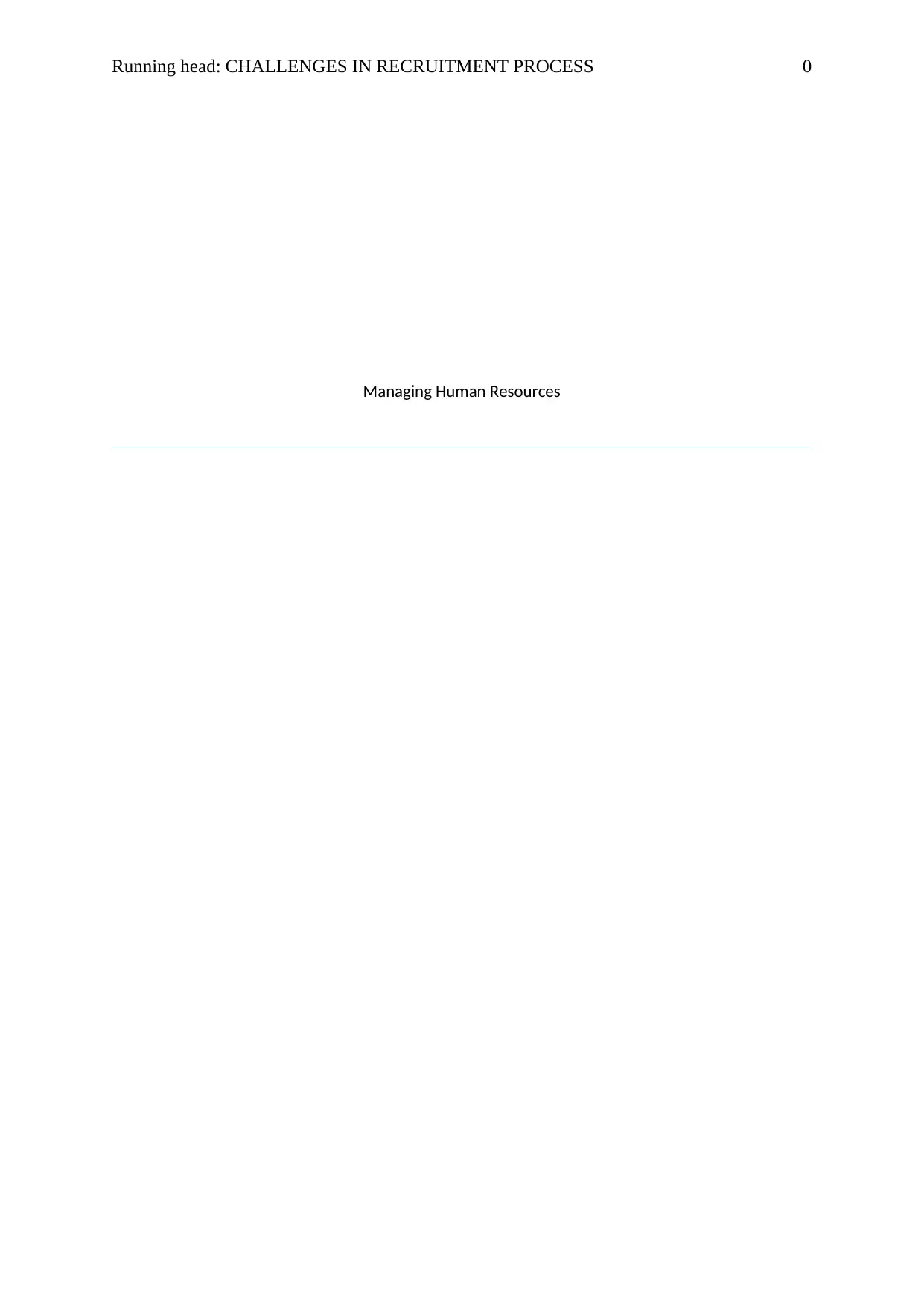
Running head: CHALLENGES IN RECRUITMENT PROCESS 0
Managing Human Resources
Managing Human Resources
Paraphrase This Document
Need a fresh take? Get an instant paraphrase of this document with our AI Paraphraser
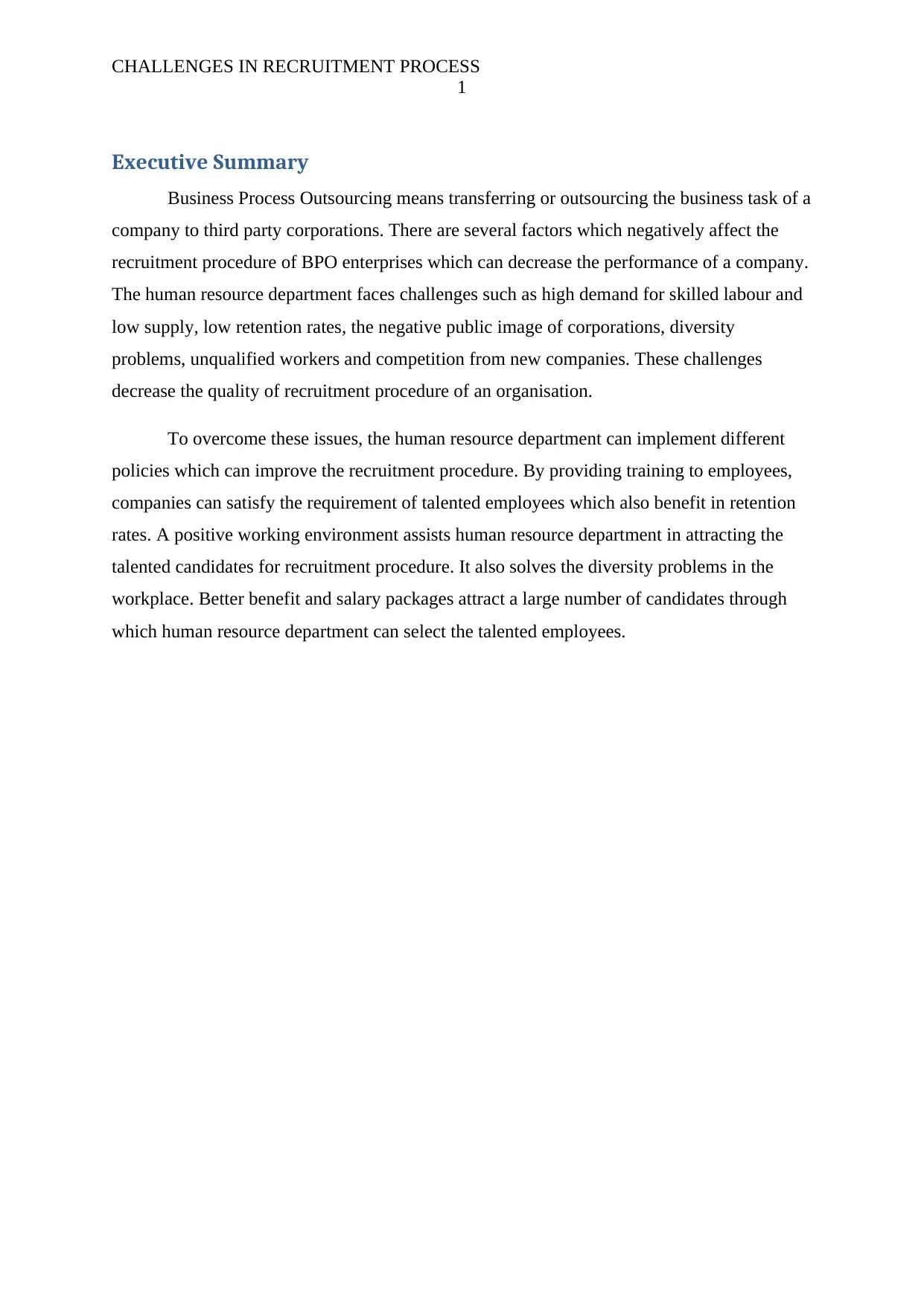
CHALLENGES IN RECRUITMENT PROCESS
1
Executive Summary
Business Process Outsourcing means transferring or outsourcing the business task of a
company to third party corporations. There are several factors which negatively affect the
recruitment procedure of BPO enterprises which can decrease the performance of a company.
The human resource department faces challenges such as high demand for skilled labour and
low supply, low retention rates, the negative public image of corporations, diversity
problems, unqualified workers and competition from new companies. These challenges
decrease the quality of recruitment procedure of an organisation.
To overcome these issues, the human resource department can implement different
policies which can improve the recruitment procedure. By providing training to employees,
companies can satisfy the requirement of talented employees which also benefit in retention
rates. A positive working environment assists human resource department in attracting the
talented candidates for recruitment procedure. It also solves the diversity problems in the
workplace. Better benefit and salary packages attract a large number of candidates through
which human resource department can select the talented employees.
1
Executive Summary
Business Process Outsourcing means transferring or outsourcing the business task of a
company to third party corporations. There are several factors which negatively affect the
recruitment procedure of BPO enterprises which can decrease the performance of a company.
The human resource department faces challenges such as high demand for skilled labour and
low supply, low retention rates, the negative public image of corporations, diversity
problems, unqualified workers and competition from new companies. These challenges
decrease the quality of recruitment procedure of an organisation.
To overcome these issues, the human resource department can implement different
policies which can improve the recruitment procedure. By providing training to employees,
companies can satisfy the requirement of talented employees which also benefit in retention
rates. A positive working environment assists human resource department in attracting the
talented candidates for recruitment procedure. It also solves the diversity problems in the
workplace. Better benefit and salary packages attract a large number of candidates through
which human resource department can select the talented employees.
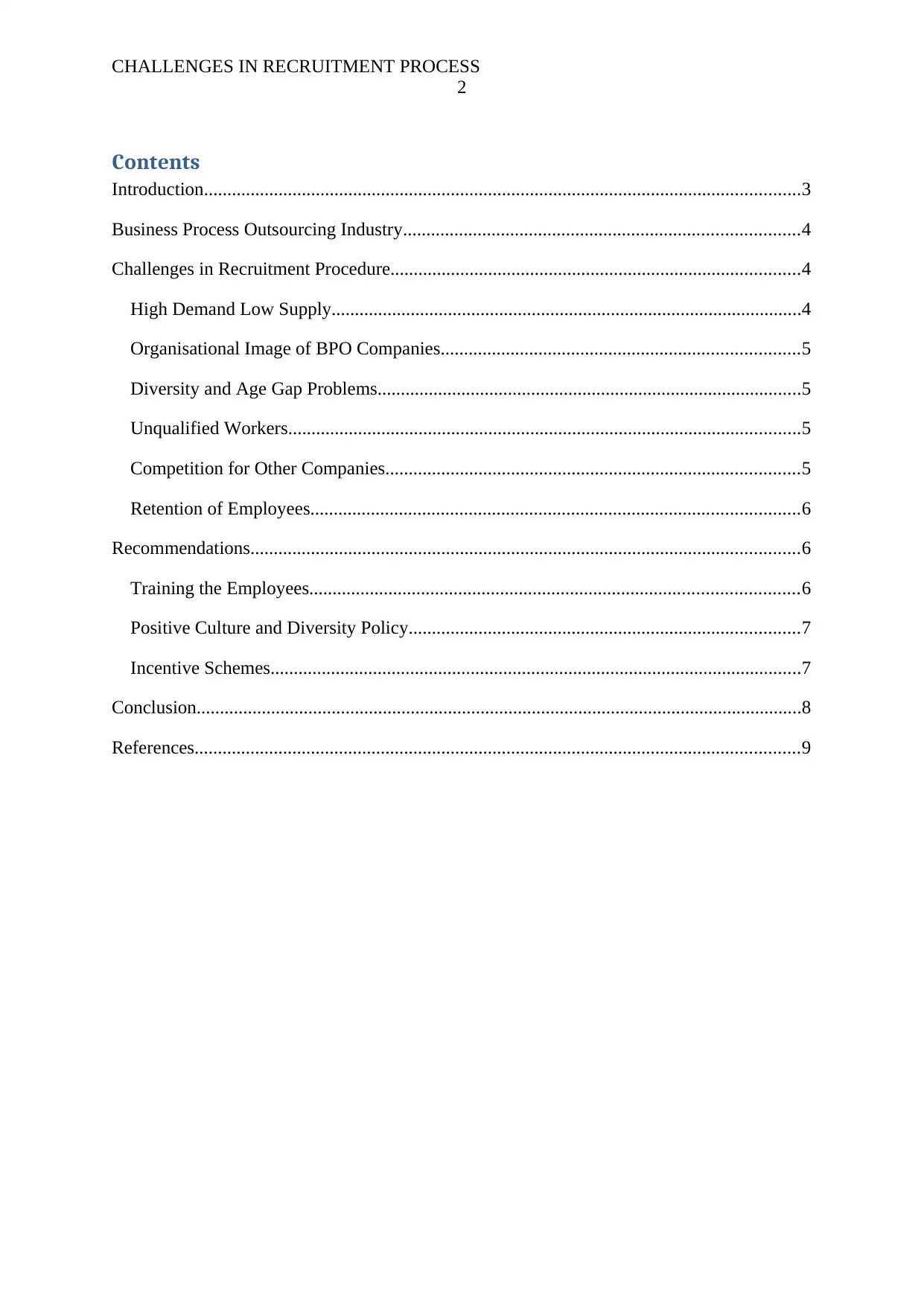
CHALLENGES IN RECRUITMENT PROCESS
2
Contents
Introduction................................................................................................................................3
Business Process Outsourcing Industry.....................................................................................4
Challenges in Recruitment Procedure........................................................................................4
High Demand Low Supply.....................................................................................................4
Organisational Image of BPO Companies.............................................................................5
Diversity and Age Gap Problems...........................................................................................5
Unqualified Workers..............................................................................................................5
Competition for Other Companies.........................................................................................5
Retention of Employees.........................................................................................................6
Recommendations......................................................................................................................6
Training the Employees.........................................................................................................6
Positive Culture and Diversity Policy....................................................................................7
Incentive Schemes..................................................................................................................7
Conclusion..................................................................................................................................8
References..................................................................................................................................9
2
Contents
Introduction................................................................................................................................3
Business Process Outsourcing Industry.....................................................................................4
Challenges in Recruitment Procedure........................................................................................4
High Demand Low Supply.....................................................................................................4
Organisational Image of BPO Companies.............................................................................5
Diversity and Age Gap Problems...........................................................................................5
Unqualified Workers..............................................................................................................5
Competition for Other Companies.........................................................................................5
Retention of Employees.........................................................................................................6
Recommendations......................................................................................................................6
Training the Employees.........................................................................................................6
Positive Culture and Diversity Policy....................................................................................7
Incentive Schemes..................................................................................................................7
Conclusion..................................................................................................................................8
References..................................................................................................................................9
⊘ This is a preview!⊘
Do you want full access?
Subscribe today to unlock all pages.

Trusted by 1+ million students worldwide
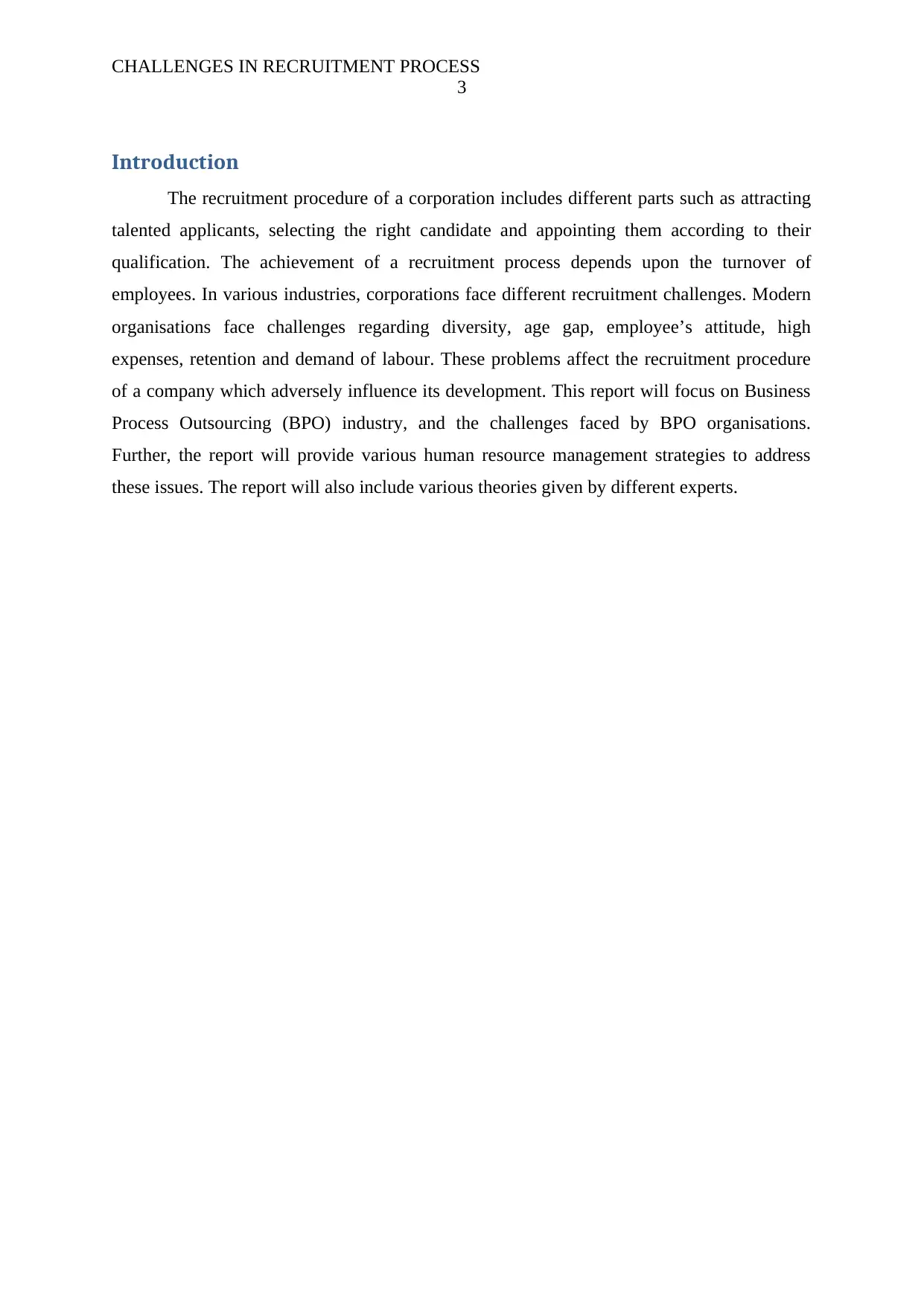
CHALLENGES IN RECRUITMENT PROCESS
3
Introduction
The recruitment procedure of a corporation includes different parts such as attracting
talented applicants, selecting the right candidate and appointing them according to their
qualification. The achievement of a recruitment process depends upon the turnover of
employees. In various industries, corporations face different recruitment challenges. Modern
organisations face challenges regarding diversity, age gap, employee’s attitude, high
expenses, retention and demand of labour. These problems affect the recruitment procedure
of a company which adversely influence its development. This report will focus on Business
Process Outsourcing (BPO) industry, and the challenges faced by BPO organisations.
Further, the report will provide various human resource management strategies to address
these issues. The report will also include various theories given by different experts.
3
Introduction
The recruitment procedure of a corporation includes different parts such as attracting
talented applicants, selecting the right candidate and appointing them according to their
qualification. The achievement of a recruitment process depends upon the turnover of
employees. In various industries, corporations face different recruitment challenges. Modern
organisations face challenges regarding diversity, age gap, employee’s attitude, high
expenses, retention and demand of labour. These problems affect the recruitment procedure
of a company which adversely influence its development. This report will focus on Business
Process Outsourcing (BPO) industry, and the challenges faced by BPO organisations.
Further, the report will provide various human resource management strategies to address
these issues. The report will also include various theories given by different experts.
Paraphrase This Document
Need a fresh take? Get an instant paraphrase of this document with our AI Paraphraser

CHALLENGES IN RECRUITMENT PROCESS
4
Business Process Outsourcing Industry
Business process outsourcing is a corporate strategy implemented by various
organisations; it includes contracting or outsourcing the non-primary corporate actions to
third-party corporations. According to Kuruvilla & Ranganathan (2010), the non-primary
activities include various secondary tasks such as human resource management, IT
department, customer support, payrolls or call center facilities. International organisations
outsource their business to countries such as India, Thailand, China or Philippines. There are
various reasons for which a corporation outsources their business such as it reduces the cost
of operations, professional workforce, better productivity and low-cost employees. As per
Caniglia, Ramachandran & Khanna (2005), the BPO industry faces various challenges such
as a change in government regulations, the attitude of employees, security breaches,
underestimating the expenses or bad reputation.
Challenges in Recruitment Procedure
The companies which provide BPO services face various problems while recruiting
new employees. Following are few of the aspects which affect the hiring process of a
corporation.
High Demand Low Supply
In BPO industry, the rate of development is significantly high, which require firms to
hire talented employees. As per Liu & Nagurney (2013), due to the globalisation, the demand
for talented employees has raised considerably in past few decades. Every human resource
department prefers to hire only the talented employee, but the number of talented employees
is low in BPO industry. Most of the BPO organisations are situated in developing countries
such as India, Malaysia or Thailand.
The corporations choose these countries because they have a high number of
employees who work at lower rates than compared to developed countries. But, most of those
employees do not have proper knowledge of working in a BPO industry, due to lack of
literacy rates, under development in technology and low economy. To fulfill the demand for
skilled employees the supply is not sufficient, therefore, companies are required to pay high
salaries to attract talented employees. While recruiting the employees, human resource
department faces difficulty in the situation (Whitaker, Mithas & Krishnan 2010).
4
Business Process Outsourcing Industry
Business process outsourcing is a corporate strategy implemented by various
organisations; it includes contracting or outsourcing the non-primary corporate actions to
third-party corporations. According to Kuruvilla & Ranganathan (2010), the non-primary
activities include various secondary tasks such as human resource management, IT
department, customer support, payrolls or call center facilities. International organisations
outsource their business to countries such as India, Thailand, China or Philippines. There are
various reasons for which a corporation outsources their business such as it reduces the cost
of operations, professional workforce, better productivity and low-cost employees. As per
Caniglia, Ramachandran & Khanna (2005), the BPO industry faces various challenges such
as a change in government regulations, the attitude of employees, security breaches,
underestimating the expenses or bad reputation.
Challenges in Recruitment Procedure
The companies which provide BPO services face various problems while recruiting
new employees. Following are few of the aspects which affect the hiring process of a
corporation.
High Demand Low Supply
In BPO industry, the rate of development is significantly high, which require firms to
hire talented employees. As per Liu & Nagurney (2013), due to the globalisation, the demand
for talented employees has raised considerably in past few decades. Every human resource
department prefers to hire only the talented employee, but the number of talented employees
is low in BPO industry. Most of the BPO organisations are situated in developing countries
such as India, Malaysia or Thailand.
The corporations choose these countries because they have a high number of
employees who work at lower rates than compared to developed countries. But, most of those
employees do not have proper knowledge of working in a BPO industry, due to lack of
literacy rates, under development in technology and low economy. To fulfill the demand for
skilled employees the supply is not sufficient, therefore, companies are required to pay high
salaries to attract talented employees. While recruiting the employees, human resource
department faces difficulty in the situation (Whitaker, Mithas & Krishnan 2010).

CHALLENGES IN RECRUITMENT PROCESS
5
Organisational Image of BPO Companies
The reputation of BPO corporations is low in countries such as India because the
working hours are high and the pay grade is low. To attract potential talented candidates for
recruitment, the companies are requiring maintaining a positive image in between public.
Most of the people who are working in BPO industry did not prefer to work in them.
Therefore, the number of employee turnover is significantly high in BPO sector (Ghodeswar
& Vaidyanathan 2008).
Diversity and Age Gap Problems
While recruiting new employees, human resource department faces issues regarding
diversity and age of candidates. Farndale, Scullion, & Sparrow (2010) provided that the BPO
organisation did not prefer to hire elder employees because they did not have the technical
knowledge and their productivity is also low. The maximum number of employees in BPO
sector is young or adults which reduces the options for HR department because people do not
prefer to work for a BPO. In case of gender, the discrimination between male and females is
considerably high in BPO sector. There is just 35 percent of women workers in BPO industry
and companies. Most of the company did not hire female employees because they have a
problem regarding night shift and other family issues.
Unqualified Workers
Most of the BPO companies are present in Asian countries such as India, China, and
Malaysia. According to Mehta, Armenakis, Mehta & Irani (2006), these countries are facing
issues relating to illiteracy and poor quality of education. A worker who works in BPO
companies does not possess basic skills such as operating a computer or speaking English.
The degrees provided by candidates are usually not authentic, their skills do not match with
their qualifications, and they failed to understand most of the tactics and strategies made by
top level management. Unskilled labour creates various kinds of problems for an organisation
and their human resource department. Human resource department has to put more efforts in
hiring an appropriate candidate; they have to make a lengthy selection prices in order to hire a
correct candidate.
Competition for Other Companies
BPO industry has seen remarkable in past few decades and growth opportunity for an
employee is significantly high in this sector. Lacity, Solomon, Yan & Willcocks (2011)
provided that growth opportunity for an employee is considerably high therefore employees
5
Organisational Image of BPO Companies
The reputation of BPO corporations is low in countries such as India because the
working hours are high and the pay grade is low. To attract potential talented candidates for
recruitment, the companies are requiring maintaining a positive image in between public.
Most of the people who are working in BPO industry did not prefer to work in them.
Therefore, the number of employee turnover is significantly high in BPO sector (Ghodeswar
& Vaidyanathan 2008).
Diversity and Age Gap Problems
While recruiting new employees, human resource department faces issues regarding
diversity and age of candidates. Farndale, Scullion, & Sparrow (2010) provided that the BPO
organisation did not prefer to hire elder employees because they did not have the technical
knowledge and their productivity is also low. The maximum number of employees in BPO
sector is young or adults which reduces the options for HR department because people do not
prefer to work for a BPO. In case of gender, the discrimination between male and females is
considerably high in BPO sector. There is just 35 percent of women workers in BPO industry
and companies. Most of the company did not hire female employees because they have a
problem regarding night shift and other family issues.
Unqualified Workers
Most of the BPO companies are present in Asian countries such as India, China, and
Malaysia. According to Mehta, Armenakis, Mehta & Irani (2006), these countries are facing
issues relating to illiteracy and poor quality of education. A worker who works in BPO
companies does not possess basic skills such as operating a computer or speaking English.
The degrees provided by candidates are usually not authentic, their skills do not match with
their qualifications, and they failed to understand most of the tactics and strategies made by
top level management. Unskilled labour creates various kinds of problems for an organisation
and their human resource department. Human resource department has to put more efforts in
hiring an appropriate candidate; they have to make a lengthy selection prices in order to hire a
correct candidate.
Competition for Other Companies
BPO industry has seen remarkable in past few decades and growth opportunity for an
employee is significantly high in this sector. Lacity, Solomon, Yan & Willcocks (2011)
provided that growth opportunity for an employee is considerably high therefore employees
⊘ This is a preview!⊘
Do you want full access?
Subscribe today to unlock all pages.

Trusted by 1+ million students worldwide
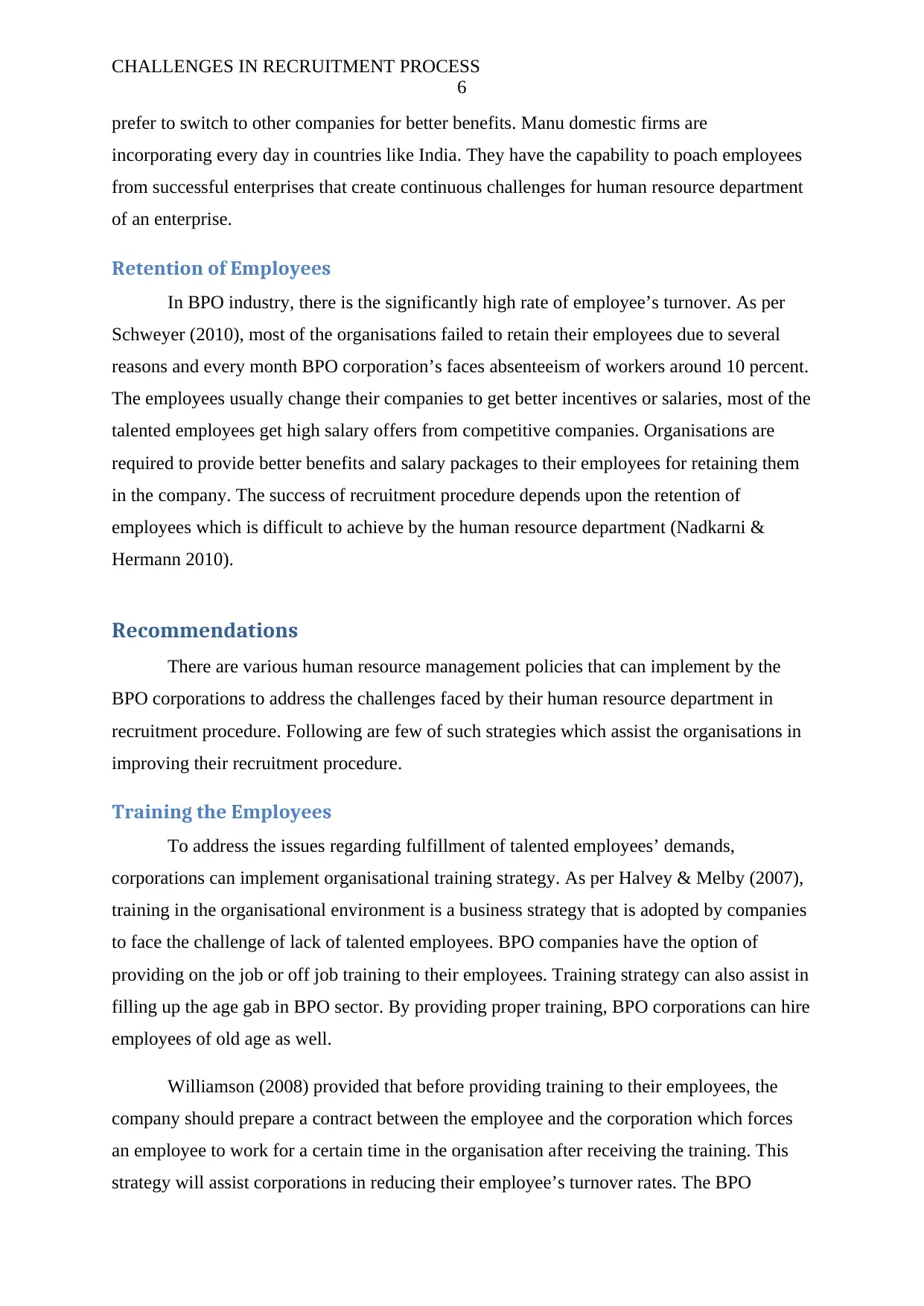
CHALLENGES IN RECRUITMENT PROCESS
6
prefer to switch to other companies for better benefits. Manu domestic firms are
incorporating every day in countries like India. They have the capability to poach employees
from successful enterprises that create continuous challenges for human resource department
of an enterprise.
Retention of Employees
In BPO industry, there is the significantly high rate of employee’s turnover. As per
Schweyer (2010), most of the organisations failed to retain their employees due to several
reasons and every month BPO corporation’s faces absenteeism of workers around 10 percent.
The employees usually change their companies to get better incentives or salaries, most of the
talented employees get high salary offers from competitive companies. Organisations are
required to provide better benefits and salary packages to their employees for retaining them
in the company. The success of recruitment procedure depends upon the retention of
employees which is difficult to achieve by the human resource department (Nadkarni &
Hermann 2010).
Recommendations
There are various human resource management policies that can implement by the
BPO corporations to address the challenges faced by their human resource department in
recruitment procedure. Following are few of such strategies which assist the organisations in
improving their recruitment procedure.
Training the Employees
To address the issues regarding fulfillment of talented employees’ demands,
corporations can implement organisational training strategy. As per Halvey & Melby (2007),
training in the organisational environment is a business strategy that is adopted by companies
to face the challenge of lack of talented employees. BPO companies have the option of
providing on the job or off job training to their employees. Training strategy can also assist in
filling up the age gab in BPO sector. By providing proper training, BPO corporations can hire
employees of old age as well.
Williamson (2008) provided that before providing training to their employees, the
company should prepare a contract between the employee and the corporation which forces
an employee to work for a certain time in the organisation after receiving the training. This
strategy will assist corporations in reducing their employee’s turnover rates. The BPO
6
prefer to switch to other companies for better benefits. Manu domestic firms are
incorporating every day in countries like India. They have the capability to poach employees
from successful enterprises that create continuous challenges for human resource department
of an enterprise.
Retention of Employees
In BPO industry, there is the significantly high rate of employee’s turnover. As per
Schweyer (2010), most of the organisations failed to retain their employees due to several
reasons and every month BPO corporation’s faces absenteeism of workers around 10 percent.
The employees usually change their companies to get better incentives or salaries, most of the
talented employees get high salary offers from competitive companies. Organisations are
required to provide better benefits and salary packages to their employees for retaining them
in the company. The success of recruitment procedure depends upon the retention of
employees which is difficult to achieve by the human resource department (Nadkarni &
Hermann 2010).
Recommendations
There are various human resource management policies that can implement by the
BPO corporations to address the challenges faced by their human resource department in
recruitment procedure. Following are few of such strategies which assist the organisations in
improving their recruitment procedure.
Training the Employees
To address the issues regarding fulfillment of talented employees’ demands,
corporations can implement organisational training strategy. As per Halvey & Melby (2007),
training in the organisational environment is a business strategy that is adopted by companies
to face the challenge of lack of talented employees. BPO companies have the option of
providing on the job or off job training to their employees. Training strategy can also assist in
filling up the age gab in BPO sector. By providing proper training, BPO corporations can hire
employees of old age as well.
Williamson (2008) provided that before providing training to their employees, the
company should prepare a contract between the employee and the corporation which forces
an employee to work for a certain time in the organisation after receiving the training. This
strategy will assist corporations in reducing their employee’s turnover rates. The BPO
Paraphrase This Document
Need a fresh take? Get an instant paraphrase of this document with our AI Paraphraser
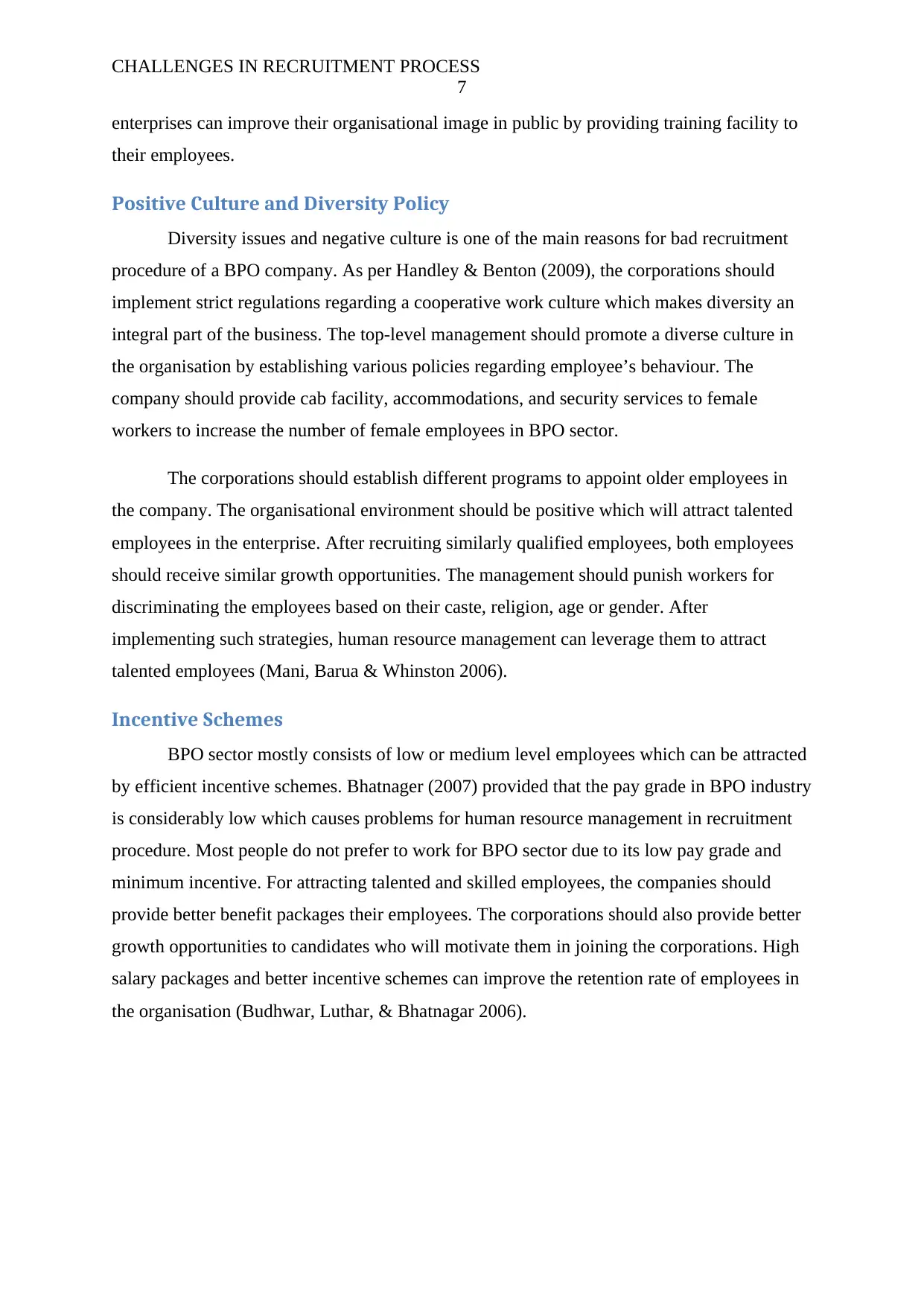
CHALLENGES IN RECRUITMENT PROCESS
7
enterprises can improve their organisational image in public by providing training facility to
their employees.
Positive Culture and Diversity Policy
Diversity issues and negative culture is one of the main reasons for bad recruitment
procedure of a BPO company. As per Handley & Benton (2009), the corporations should
implement strict regulations regarding a cooperative work culture which makes diversity an
integral part of the business. The top-level management should promote a diverse culture in
the organisation by establishing various policies regarding employee’s behaviour. The
company should provide cab facility, accommodations, and security services to female
workers to increase the number of female employees in BPO sector.
The corporations should establish different programs to appoint older employees in
the company. The organisational environment should be positive which will attract talented
employees in the enterprise. After recruiting similarly qualified employees, both employees
should receive similar growth opportunities. The management should punish workers for
discriminating the employees based on their caste, religion, age or gender. After
implementing such strategies, human resource management can leverage them to attract
talented employees (Mani, Barua & Whinston 2006).
Incentive Schemes
BPO sector mostly consists of low or medium level employees which can be attracted
by efficient incentive schemes. Bhatnager (2007) provided that the pay grade in BPO industry
is considerably low which causes problems for human resource management in recruitment
procedure. Most people do not prefer to work for BPO sector due to its low pay grade and
minimum incentive. For attracting talented and skilled employees, the companies should
provide better benefit packages their employees. The corporations should also provide better
growth opportunities to candidates who will motivate them in joining the corporations. High
salary packages and better incentive schemes can improve the retention rate of employees in
the organisation (Budhwar, Luthar, & Bhatnagar 2006).
7
enterprises can improve their organisational image in public by providing training facility to
their employees.
Positive Culture and Diversity Policy
Diversity issues and negative culture is one of the main reasons for bad recruitment
procedure of a BPO company. As per Handley & Benton (2009), the corporations should
implement strict regulations regarding a cooperative work culture which makes diversity an
integral part of the business. The top-level management should promote a diverse culture in
the organisation by establishing various policies regarding employee’s behaviour. The
company should provide cab facility, accommodations, and security services to female
workers to increase the number of female employees in BPO sector.
The corporations should establish different programs to appoint older employees in
the company. The organisational environment should be positive which will attract talented
employees in the enterprise. After recruiting similarly qualified employees, both employees
should receive similar growth opportunities. The management should punish workers for
discriminating the employees based on their caste, religion, age or gender. After
implementing such strategies, human resource management can leverage them to attract
talented employees (Mani, Barua & Whinston 2006).
Incentive Schemes
BPO sector mostly consists of low or medium level employees which can be attracted
by efficient incentive schemes. Bhatnager (2007) provided that the pay grade in BPO industry
is considerably low which causes problems for human resource management in recruitment
procedure. Most people do not prefer to work for BPO sector due to its low pay grade and
minimum incentive. For attracting talented and skilled employees, the companies should
provide better benefit packages their employees. The corporations should also provide better
growth opportunities to candidates who will motivate them in joining the corporations. High
salary packages and better incentive schemes can improve the retention rate of employees in
the organisation (Budhwar, Luthar, & Bhatnagar 2006).
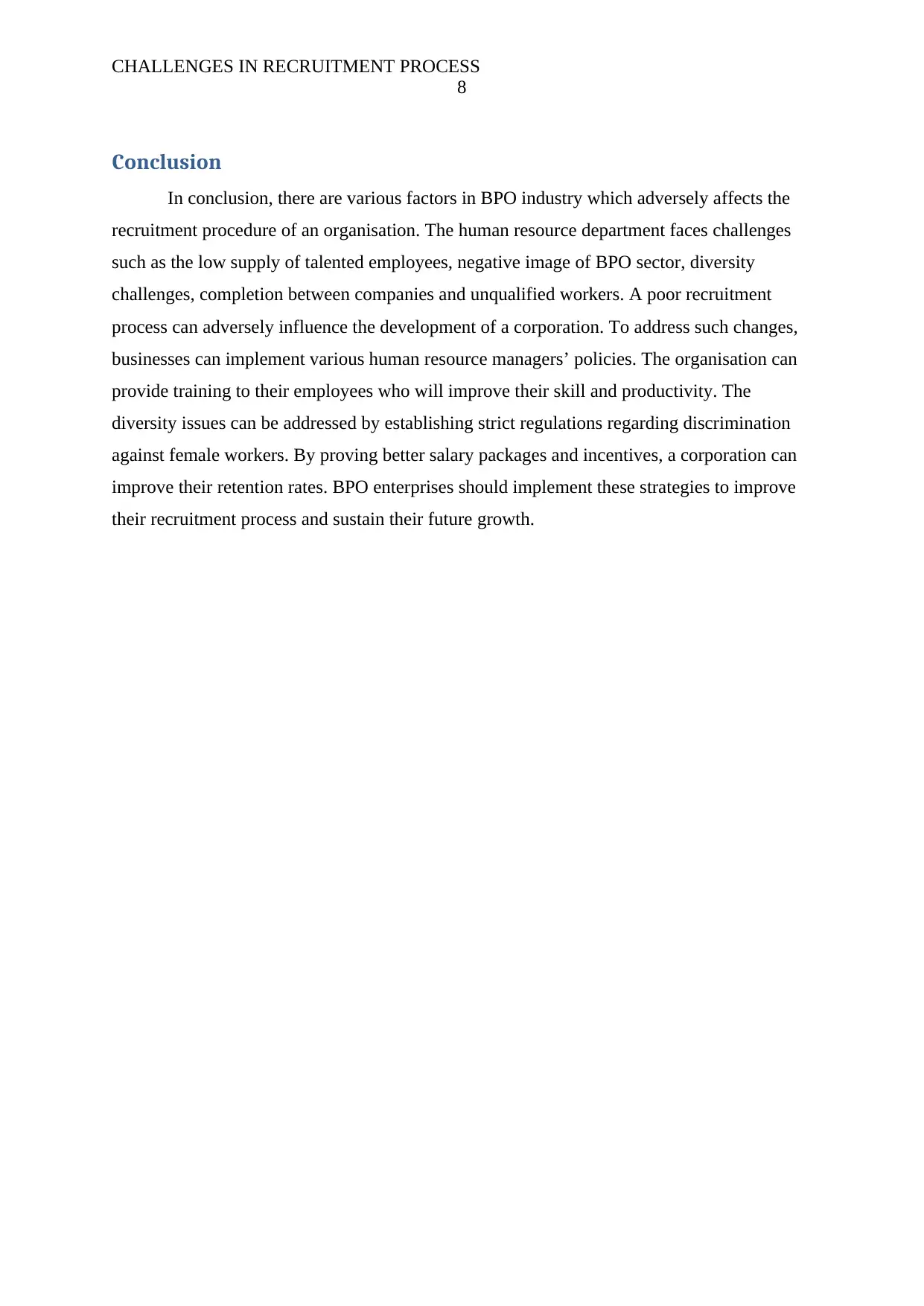
CHALLENGES IN RECRUITMENT PROCESS
8
Conclusion
In conclusion, there are various factors in BPO industry which adversely affects the
recruitment procedure of an organisation. The human resource department faces challenges
such as the low supply of talented employees, negative image of BPO sector, diversity
challenges, completion between companies and unqualified workers. A poor recruitment
process can adversely influence the development of a corporation. To address such changes,
businesses can implement various human resource managers’ policies. The organisation can
provide training to their employees who will improve their skill and productivity. The
diversity issues can be addressed by establishing strict regulations regarding discrimination
against female workers. By proving better salary packages and incentives, a corporation can
improve their retention rates. BPO enterprises should implement these strategies to improve
their recruitment process and sustain their future growth.
8
Conclusion
In conclusion, there are various factors in BPO industry which adversely affects the
recruitment procedure of an organisation. The human resource department faces challenges
such as the low supply of talented employees, negative image of BPO sector, diversity
challenges, completion between companies and unqualified workers. A poor recruitment
process can adversely influence the development of a corporation. To address such changes,
businesses can implement various human resource managers’ policies. The organisation can
provide training to their employees who will improve their skill and productivity. The
diversity issues can be addressed by establishing strict regulations regarding discrimination
against female workers. By proving better salary packages and incentives, a corporation can
improve their retention rates. BPO enterprises should implement these strategies to improve
their recruitment process and sustain their future growth.
⊘ This is a preview!⊘
Do you want full access?
Subscribe today to unlock all pages.

Trusted by 1+ million students worldwide
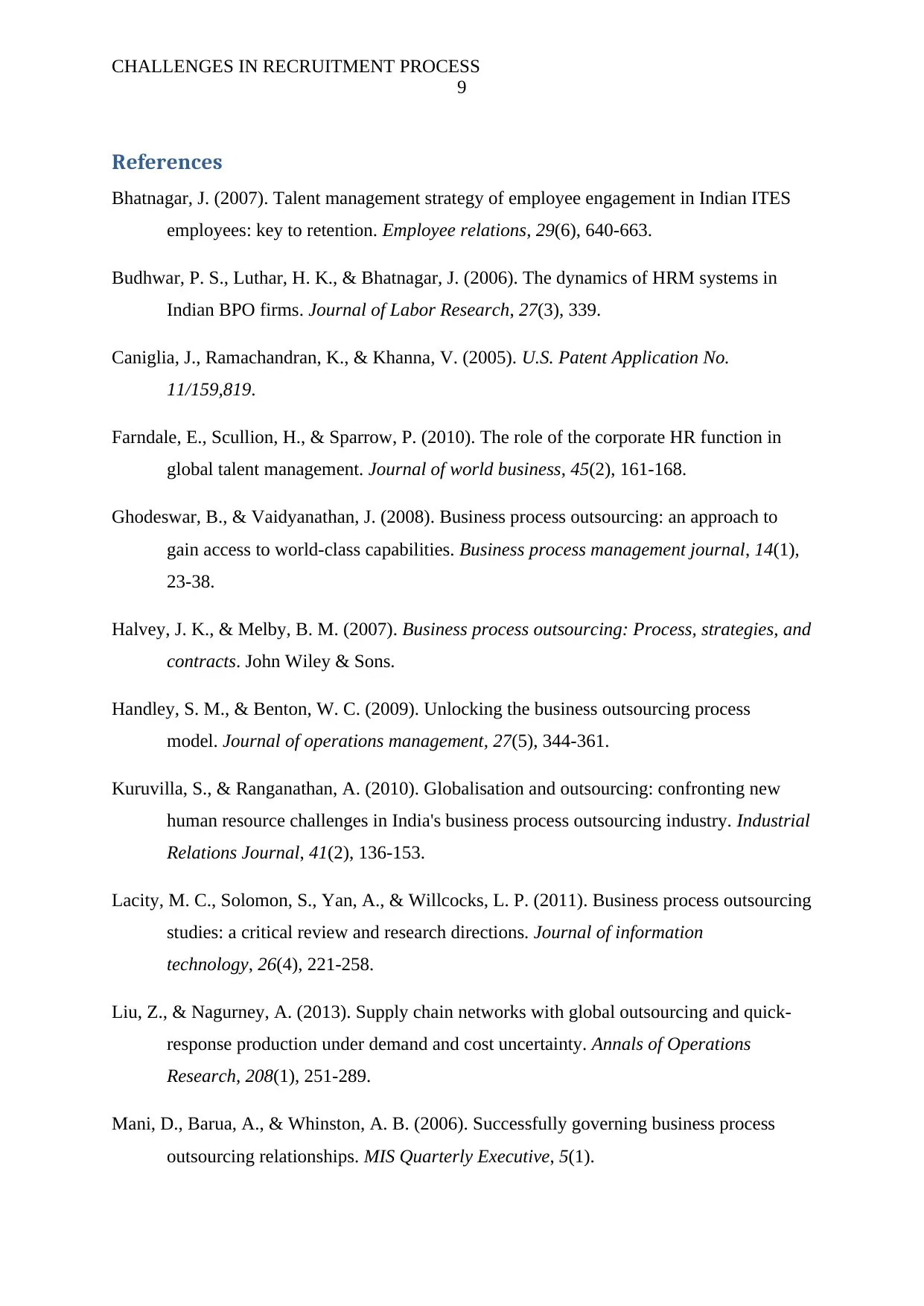
CHALLENGES IN RECRUITMENT PROCESS
9
References
Bhatnagar, J. (2007). Talent management strategy of employee engagement in Indian ITES
employees: key to retention. Employee relations, 29(6), 640-663.
Budhwar, P. S., Luthar, H. K., & Bhatnagar, J. (2006). The dynamics of HRM systems in
Indian BPO firms. Journal of Labor Research, 27(3), 339.
Caniglia, J., Ramachandran, K., & Khanna, V. (2005). U.S. Patent Application No.
11/159,819.
Farndale, E., Scullion, H., & Sparrow, P. (2010). The role of the corporate HR function in
global talent management. Journal of world business, 45(2), 161-168.
Ghodeswar, B., & Vaidyanathan, J. (2008). Business process outsourcing: an approach to
gain access to world-class capabilities. Business process management journal, 14(1),
23-38.
Halvey, J. K., & Melby, B. M. (2007). Business process outsourcing: Process, strategies, and
contracts. John Wiley & Sons.
Handley, S. M., & Benton, W. C. (2009). Unlocking the business outsourcing process
model. Journal of operations management, 27(5), 344-361.
Kuruvilla, S., & Ranganathan, A. (2010). Globalisation and outsourcing: confronting new
human resource challenges in India's business process outsourcing industry. Industrial
Relations Journal, 41(2), 136-153.
Lacity, M. C., Solomon, S., Yan, A., & Willcocks, L. P. (2011). Business process outsourcing
studies: a critical review and research directions. Journal of information
technology, 26(4), 221-258.
Liu, Z., & Nagurney, A. (2013). Supply chain networks with global outsourcing and quick-
response production under demand and cost uncertainty. Annals of Operations
Research, 208(1), 251-289.
Mani, D., Barua, A., & Whinston, A. B. (2006). Successfully governing business process
outsourcing relationships. MIS Quarterly Executive, 5(1).
9
References
Bhatnagar, J. (2007). Talent management strategy of employee engagement in Indian ITES
employees: key to retention. Employee relations, 29(6), 640-663.
Budhwar, P. S., Luthar, H. K., & Bhatnagar, J. (2006). The dynamics of HRM systems in
Indian BPO firms. Journal of Labor Research, 27(3), 339.
Caniglia, J., Ramachandran, K., & Khanna, V. (2005). U.S. Patent Application No.
11/159,819.
Farndale, E., Scullion, H., & Sparrow, P. (2010). The role of the corporate HR function in
global talent management. Journal of world business, 45(2), 161-168.
Ghodeswar, B., & Vaidyanathan, J. (2008). Business process outsourcing: an approach to
gain access to world-class capabilities. Business process management journal, 14(1),
23-38.
Halvey, J. K., & Melby, B. M. (2007). Business process outsourcing: Process, strategies, and
contracts. John Wiley & Sons.
Handley, S. M., & Benton, W. C. (2009). Unlocking the business outsourcing process
model. Journal of operations management, 27(5), 344-361.
Kuruvilla, S., & Ranganathan, A. (2010). Globalisation and outsourcing: confronting new
human resource challenges in India's business process outsourcing industry. Industrial
Relations Journal, 41(2), 136-153.
Lacity, M. C., Solomon, S., Yan, A., & Willcocks, L. P. (2011). Business process outsourcing
studies: a critical review and research directions. Journal of information
technology, 26(4), 221-258.
Liu, Z., & Nagurney, A. (2013). Supply chain networks with global outsourcing and quick-
response production under demand and cost uncertainty. Annals of Operations
Research, 208(1), 251-289.
Mani, D., Barua, A., & Whinston, A. B. (2006). Successfully governing business process
outsourcing relationships. MIS Quarterly Executive, 5(1).
Paraphrase This Document
Need a fresh take? Get an instant paraphrase of this document with our AI Paraphraser

CHALLENGES IN RECRUITMENT PROCESS
10
Mehta, A., Armenakis, A., Mehta, N., & Irani, F. (2006). Challenges and opportunities of
business process outsourcing in India. Journal of Labor Research, 27(3), 323-338.
Nadkarni, S., & Herrmann, P. O. L. (2010). CEO personality, strategic flexibility, and firm
performance: The case of the Indian business process outsourcing industry. Academy
of Management Journal, 53(5), 1050-1073.
Schweyer, A. (2010). Talent management systems: Best practices in technology solutions for
recruitment, retention and workforce planning. John Wiley & Sons.
Whitaker, J., Mithas, S., & Krishnan, M. S. (2010). Organizational learning and capabilities
for onshore and offshore business process outsourcing. Journal of Management
Information Systems, 27(3), 11-42.
Williamson, O. E. (2008). Outsourcing: Transaction cost economics and supply chain
management. Journal of supply chain management, 44(2), 5-16.
10
Mehta, A., Armenakis, A., Mehta, N., & Irani, F. (2006). Challenges and opportunities of
business process outsourcing in India. Journal of Labor Research, 27(3), 323-338.
Nadkarni, S., & Herrmann, P. O. L. (2010). CEO personality, strategic flexibility, and firm
performance: The case of the Indian business process outsourcing industry. Academy
of Management Journal, 53(5), 1050-1073.
Schweyer, A. (2010). Talent management systems: Best practices in technology solutions for
recruitment, retention and workforce planning. John Wiley & Sons.
Whitaker, J., Mithas, S., & Krishnan, M. S. (2010). Organizational learning and capabilities
for onshore and offshore business process outsourcing. Journal of Management
Information Systems, 27(3), 11-42.
Williamson, O. E. (2008). Outsourcing: Transaction cost economics and supply chain
management. Journal of supply chain management, 44(2), 5-16.
1 out of 11
Related Documents
Your All-in-One AI-Powered Toolkit for Academic Success.
+13062052269
info@desklib.com
Available 24*7 on WhatsApp / Email
![[object Object]](/_next/static/media/star-bottom.7253800d.svg)
Unlock your academic potential
Copyright © 2020–2025 A2Z Services. All Rights Reserved. Developed and managed by ZUCOL.





